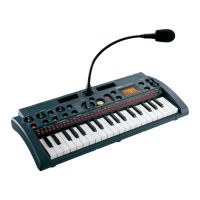Appendix
67
Before you suspect a malfunction, please check the following items.
Power does not turn on
❏ Is the AC adapter connected to an outlet? (☞p.14)
❏ Is the power switch set to the on position (pressed inward)? (☞p.14)
❏ If you’re using batteries, are the batteries properly inserted? (☞p.14)
No sound
❏ Is your power amp or headphones connected to the correct connector?
(☞p.13)
❏ Is your connected power amp or other system powered-on, and is the
volume turned up?
❏ Is the [VOLUME] knob turned up so that sound will be audible?
❏ Is the “GLOBAL” page LOCAL setting turned “ON”? (☞p.39)
Sound does not stop
❏ If a problem occurs and a note becomes stuck, press the [ENTER/SHIFT]
button and the [EXIT] button simultaneously to execute an All Sound
Off.
Duplicate notes are sounded
❏ Is the “GLOBAL” page LOCAL setting turned “OFF”? (☞p.39)
If a sequencer is connected, duplicate notes may be sounded by the echo
back from the sequencer (i.e., the performance data transmitted when
you play the microSAMPLER is being sent back to the microSAMPLER).
The sound or operation differs from when you edited the setting
❏ Did you save your changes after editing? (☞p.41)
After editing, you must save your changes before you switch to a differ-
ent bank or turn off the power.
Can’t input sound
❏ Is your input source correctly connected to the AUDIO IN [L/
MONO],[R] jacks or to the [ MIC] jack? (☞p.13)
❏ If you’re using the AUDIO IN [ MIC] jack, is the AUDIO IN[ /
LINE] switch set to the “ ” position? (☞p.13)
❏ Is the AUDIO IN [GAIN] knob level turned up? (☞p.12)
Can’t save
❏ Is the “GLOBAL” page “PROTECT” setting turned “OFF”? (☞p.38)
❏ If you’re using batteries, could the batteries have run low? (☞p.14)
The microSAMPLER does not respond to MIDI data from an exter-
nal device
❏ Is the MIDI cable or USB cable connected correctly? (☞p.13)
❏ Does the MIDI channel of the data being sent from your external MIDI
device match the microSAMPLER’s MIDI channel? (☞p.39)
❏ Is the “GLOBAL” page MIDI.ROUT setting correct? (☞p.39)
Operational noises are recorded in the sample
❏ When you sample a sound that’s being input from the mic, the sounds of
button pressing or keyboard playing might be recorded. If so, you can
try either of the following two actions.
1. Automatically trim off the noises by a specified length of time. (☞p.40
“STRT.TRIM/END TRIM”)
2. Start sampling by setting the sampling parameter TRIGGER to
“THRE01–10.” (☞p.24 “TRIGGER”)
If the sampling type is “KEY GATE,” this method cannot be used since you
won’t be able to select “THRE01–10.”
Operational noises of the microSAMPLER are a problem when
using the included mic
❏ If operational noises are a problem when using microSAMPLER with the
included mic, we recommend that you use a conventional commercially
available dynamic mic mounted on a mic stand, or use a commercially
available headset mic.
Troubleshooting
Appendix

